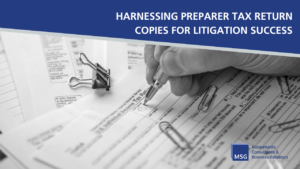Picture as you may, a matter that requires testimony regarding the fair market value of a closely held business. Like most cases of this instance, the matter will be highly contentious. I am not writing about either side’s expected arguments or their respective merits. In this instance, I want to discuss how counsel for each party organizes their material before the Court. Specifically, the income tax returns the financial experts used to form their underlying opinions.
We have all witnessed this scene before.
Counsel for each party rolls in boxes of documents in anticipation of a lengthy trial and proudly lines the front of their desk with their respective “Trial Binders.” Each binder is indexed, labeled, and, if lucky, already pre-marked as Exhibits. And, of course, courtesy hard or electronic copies are provided for the Court.
Amongst these documents are the Subject’s personal and business income tax returns.
The Subject’s income tax returns are pivotal to all stakeholders: the Plaintiff, Defendant, and even the tax preparer, who may be called to testify as a fact witness – not to mention your valuation expert who has written a report and will testify to their opinion of fair market value.
Now comes the purpose of this article.
The Plaintiff begins their case and refers to a specific page and tax return within their trial binder. You turn to that page and find identifying the referenced line item impossible. You ask your adversary and the Court for clarification, hoping a negative reference to your case preparation won’t be made. It is then you discover that the specific referenced tax return provided in your adversary’s trial binder differs from the one in the trial binder you prepared.
You both have the same tax form for the same tax year, yet the page numbers and information reported on these returns differ. How could this be?
Most, if not all, tax preparers use a computer program to prepare and file tax returns. Although the computerized returns are generally only as good as the information entered, the tax programs can generate three versions of the same return. Each version will report the same income statement and balance sheet information, but the depth of the ancillary information and detail provided in each version may differ.
These three versions of the same tax return are commonly called the Government Filing Copy, the Client Copy, and the Preparer Copy.
Government Filing Copy
The Government Filing Copy is what is sent to the taxing authorities. It generally contains the minimum detail of the three versions discussed but serves as the official record of the taxpayers filing compliance. Submitting an accurate and complete government filing copy is a legal requirement. Failure to do so can result in penalties, fines, or even criminal charges. Tax authorities use the government filing copy to verify, audit, and identify any discrepancies or red flags that may require further investigation. Tax authorities retain government filing copies for an extended period, ensuring they have access to historical taxpayer data, which helps tax enforcement, compliance checks, and statistical analysis.
Client Copy
The Client Copy of a tax return is the version provided to the taxpayer for their records. It essentially contains the same information in the government filing copy, plus several schedules and statements that are not necessary for the government filing copy but serve as a reference point for the taxpayer. The taxpayer should keep these copies for future reference, particularly if there are any inquiries by the taxing authorities – or as in this instance, subject to litigation.
Preparer Copy
As the name suggests, the Preparer Copy is a version of the tax return typically kept by the tax preparer or accountant who prepared the return. It generally contains all the relevant financial information and calculations necessary to complete the taxpayer’s return, including those not necessarily required in the government copy. This version contains much more detail than the aforementioned copies and is often used as a reference to ensure consistency and accuracy in tax filings over time. More importantly, this copy can serve as an audit trail, providing evidence of how the tax return was prepared and the calculations made.
Returning to the earlier courtroom scene, the disconnect between each tax return contained in the respective trial binders was because they were not the same version. Despite each reporting the gross revenues, expenses, and net income, the supplemental schedules and information were presented differently, including the page numbers.
Here’s the key takeaway for attorneys: always request the preparer’s copy of income tax returns in litigation. It’s the most comprehensive version and offers a deeper understanding of the document’s contents, crucial for direct or cross-examination.


